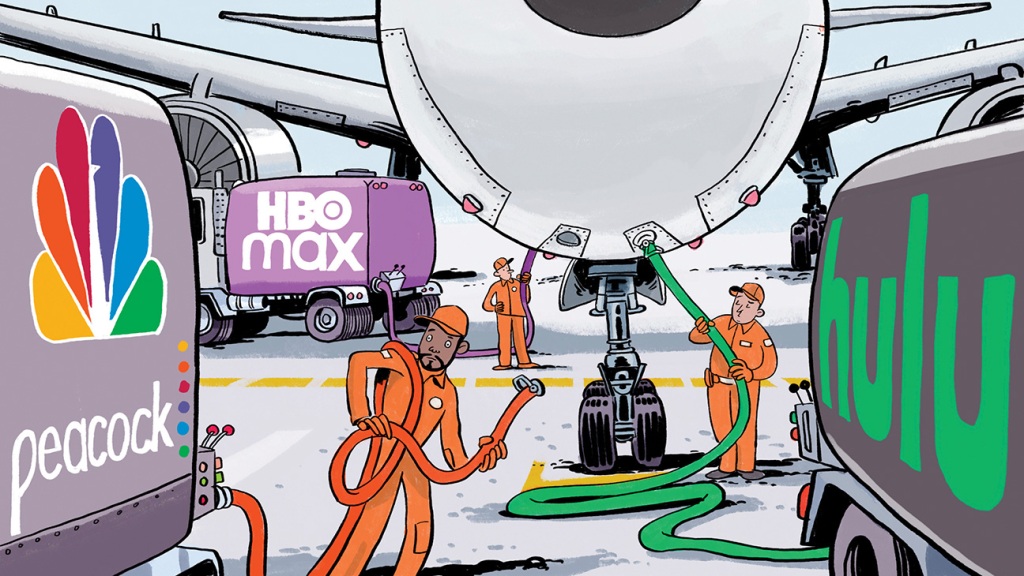
In 1921, Aeromarine Airways projected the promotional short Howdy Chicago onto a screen in the front of the cabin while flying over the Windy City, marking the first in-flight film. Cut to 100 years later, and onboard entertainment has had quite the revolution: It’s now a $250 million- to $300 million-a-year industry, according to Joe Leader, CEO of the Airline Passenger Experience Association — a network of the world’s leading airlines and suppliers — and has expanded to include films, TV, music and podcasts. In the past few years, streamers, starting with Netflix and followed by HBO Max, Hulu, Disney+ and Peacock, have continued to evolve the space, offering original content on seatback screens across the globe in addition to the classic mix of new and old theatrical releases.
Taking to the skies gives streamers a unique marketing opportunity: a captive — and likely affluent — audience of consumers who probably can afford streaming subscriptions, too. “We have passenger eyeballs for four to eight hours at a time,” says Josh Marks, CEO of onboard entertainment provider Anuvu. “If you want to hook subscribers on that new series, you’re not going to get a better marketing point than an airline.” According to the Bureau of Transportation Statistics, U.S. airlines carried 674 million passengers in 2021.
In-flight entertainment (IFE) offerings are generally programmed 90 days in advance, and with new tech, airlines can change them more easily. “[We used to rely] on what we jokingly called ‘sneakernet,’ someone coming onto the aircraft with the dongle connecting over USB and loading everything for the month,” says Leader, adding that it took about a week to update an entire fleet. “The airlines can now load the content over Wi-Fi.”
While planes can now hold lots of content on their physical servers (versus only a handful of films 15 or 20 years ago), it’s still not unlimited, resulting in a capped number of spots. Post-COVID budgets also are restricting, as the IFE industry recovers after being hit from both the airline and theater sides. “It was a double whammy,” says Terry Steiner, a distributor who notes that airline content budgets are still not back to 2019 levels. So there’s less budget for smaller, non-tentpole films (which are typically prioritized below blockbusters), especially as streamers are taking up a bigger piece of the pie. But, for indies that can land a coveted spot, Steiner says it “could be a significant chunk of change” in revenue.
Airline content deals for studios and streamers vary: Some projects are sold individually, others are part of a slate; some have exclusive deals, others are placed on many carriers at once. Hulu/Disney partners with multiple airlines, while Peacock has homed in on American and Netflix flies with Virgin. Windowing also is a challenge. Just as theaters had long held exclusive screening rights before films went to streamers, airlines typically had early access to new releases, but that’s no longer a given.
“Theatrical is sometimes not in the mix and airlines still want an early window and they want to go before streaming,” says Cathie Trotta, managing director of indie distributor Penny Black Media, who adds that airlines seek to pay significantly less for a film if it follows a streaming release. She says: “Everyone [used to] follow suit; you had your theatrical, then airline. Now, it’s all mixed up.”
While airline exclusivity is resurging in some cases — as with Top Gun: Maverick, which followed a more traditional release schedule — Leader says some streamers remain “super competitive” and want films early “as a hook to make sure that people stay with the streaming service.”
Warner Bros. Discovery content licensing exec David Decker says in-flight releases are still a key supplement to the company’s theatrical, cable and streaming offerings: “You’ll see our new releases be on airplanes in the early stages of the windowing, where it is still top of mind for everybody and they may not have caught it yet in theaters or on the streamer.” Added Peacock executive vp global partnerships and strategic development Annie Luo of the streamer’s partnership with American Airlines, “We are always looking for new and innovative ways to bring our content to customers wherever they are, even in the skies.”
Then, there’s in-flight bandwidth to consider, as many passengers are skipping the seatback screens for their phones and laptops. Experts say that’s not the way of the future, as in-flight Wi-Fi can’t support hundreds of personal devices at once. As a result, airlines are investing heavily in onboard screens. Leader points to United Airlines, which is adding 500 new planes equipped with upgraded IFE over the next five years (United said in 2021 that it would spend billions for aircraft and aircraft improvements).
“We’re heading toward a world where the seatback screen in front of you is fully connected to the internet, where the airlines and studios push content to you as an individual passenger, and where all of the systems are designed to tie in to loyalty programs and studio subscriber platforms,” says Marks. “If the airline knows that you’re a Paramount+ subscriber and they have a special deal going with HBO Max, you might get an HBO Max-heavy set of content. The airline knows a lot about you that they can use to work with the studios to make money. And, from your perspective, you interpret it as targeted content that’s more enjoyable.”
This story first appeared in the Oct. 19 issue of The Hollywood Reporter magazine. Click here to subscribe.

